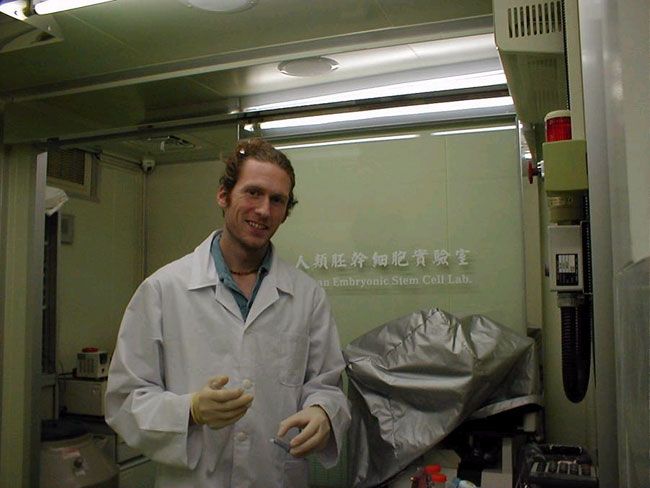At the Crossroad of Stem Cells and Computer Science

This Behind the Scenes article was provided to LiveScience in partnership with the National Science Foundation.
My blonde hair, blue eyes, and size 15 running shoes weren’t the only reasons for which I was a unique attraction at the Industrial Technology Research Institute in Hsinchu Xian, Taiwan. My background in physics and mathematics meant that I was the only member of Dr. Wannhsin Chen’s Stem Cell Engineering Group who had no experience culturing human embryonic stem cells.
I had come to the institute’s Bioengineering Division as an East Asian Pacific Summer Institute summer fellow, having come from Rutgers University in New Jersey where I’m a Ph.D. student and fellow of NSF’s Integratively Engineered Biointerfaces program. I had received cutting-edge instruction for the culturing of cells, but my experience was limited to very hardy cell lines from epithelial tissues (surface cells), and my approach to cultures was more engineering than biomedical.
However, in Taiwan my mentors were all biologists, and would only mentor me as a student of biology. They were very forgiving of my utter lack of Chinese language skills, but they were much more insistent that I speak biolog-ese. But the work was everything that I had been trained to do at the university: to be able to interface with the researchers in the basic sciences, and to synthesize the experience within the universe of biomedical engineering.
Part of the magic of modern tissue research is just how deftly an experienced biologist can look at an image of cells in a dish and know immediately which cells are healthy or not, differentiated or not. These qualitative—and in both labs, uncannily accurate—assessments not only confound the former physicist/entry-level culturist, but also place a concrete limit on the number of cells that can be evaluated in a day, and require valuable human resources –resources which periodically become susceptible to inaccuracies after long days, nearing lunch hours, or the hustle-and-bustle of a busy lab environment.
Merging statistical pattern recognition and computer vision to cell imaging, I am addressing the problem of cell sorting with novel quantitative methods. By processing hundreds of cell images, and extracting salient parameters of cell size, morphology, and structure, I seek to rigorously and objectively determine a stem cell’s status. Experimental purity dictates that I devise my algorithm “blinded”, i.e. on cell images generated by my mentors without my involvement, which is probably for the better: their cells were markedly more photogenic than mine (the only trustworthy qualitative statement this amateur can make!).
When I am finished, a computer will be able to acquire, save, filter, and scan cell images, and process them for an online categorization cell-by-cell (freeing the biologists to spend their workday innovating). The idea is to either automate the cell sorting process, increasing the through-put of cell passage, or to complement the biologist’s subjective assessments. These principles underlie a number of fields of biomedical study, including automated diagnostics, pharmoaco-theraputics, and even forensics.
Sign up for the Live Science daily newsletter now
Get the world’s most fascinating discoveries delivered straight to your inbox.
Biology and math weren’t the only things I learned during my tenure in Taiwan. I learned a lot about myself, about academia outside of the United States, and about the Taiwanese people. For many of us, it was our first time out of the country. But the training staff in Taiwan made us feel at home from the minute we arrived.
I saw the experience as an opportunity to reinvent myself as a scientist. In my round trip from Piscataway, New Jersey, to Hsinchu, Taiwan, I departed from my hometown of biomedical engineering, and landed at the crossroads of stem cell biology and computer science.
- What is a Stem Cell?
- Top 10 Mysterious Diseases
- All About Biotechnology
Editor's Note: This research was supported by the National Science Foundation (NSF), the federal agency charged with funding basic research and education across all fields of science and engineering.












